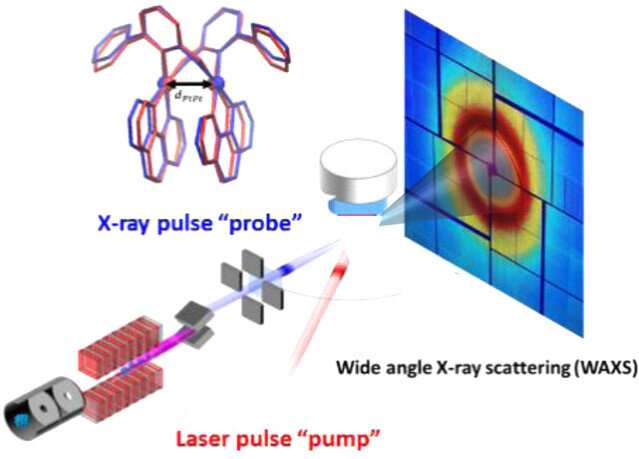This article has been reviewed according to Science X's editorial process and policies. Editors have highlighted the following attributes while ensuring the content's credibility:
fact-checked
peer-reviewed publication
trusted source
proofread
Unveiling the quantum dance: Experiments reveal nexus of vibrational and electronic dynamics

Nearly a century ago, physicists Max Born and J. Robert Oppenheimer developed an assumption regarding how quantum mechanics plays out in molecules, which are comprised of intricate systems of nuclei and electrons. The Born-Oppenheimer approximation assumes that the motion of nuclei and electrons in a molecule are independent of each other and can be treated separately.
This model works the vast majority of the time, but scientists are testing its limits. Recently, a team of scientists demonstrated the breakdown of this assumption on very fast time scales, revealing a close relationship between the dynamics of nuclei and electrons. The discovery could influence the design of molecules useful for solar energy conversion, energy production, quantum information science and more.
The team, including scientists from the U.S. Department of Energy's (DOE) Argonne National Laboratory, Northwestern University, North Carolina State University and University of Washington, recently published their discovery in two related papers in Nature and Angewandte Chemie International Edition.
"Our work reveals the interplay between the dynamics of electron spin and the vibrational dynamics of the nuclei in molecules on superfast time scales," said Shahnawaz Rafiq, a research associate at Northwestern University and first author on the Nature paper. "These properties can't be treated independently—they mix together and affect electronic dynamics in complex ways."
A phenomenon called the spin-vibronic effect occurs when changes in the motion of the nuclei within a molecule affect the motion of its electrons. When nuclei vibrate within a molecule—either due to their intrinsic energy or due to external stimuli, such as light—these vibrations can affect the motion of their electrons, which can in turn change the molecule's spin, a quantum mechanical property related to magnetism.
In a process called inter-system crossing, an excited molecule or atom changes its electronic state by flipping its electron spin orientation. Inter-system crossing plays an important role in many chemical processes, including those in photovoltaic devices, photocatalysis and even bioluminescent animals. For this crossing to be possible, it requires specific conditions and energy differences between the electronic states involved.
Since the 1960s, scientists have theorized that the spin-vibronic effect could play a role in inter-system crossing, but direct observation of the phenomenon has proven challenging, as it involves the measurement of changes in electronic, vibrational and spin states on very fast time scales.
"We used ultrashort laser pulses—down to seven femtoseconds, or seven millionths of a billionth of a second—to track the motion of nuclei and electrons in real time, which showed how the spin-vibronic effect can drive inter-system crossing," said Lin Chen, an Argonne Distinguished Fellow, professor of chemistry at Northwestern University and co-corresponding author on both studies.
"Understanding the interplay between the spin-vibronic effect and inter-system crossing could potentially lead to new ways to control and exploit the electronic and spin properties of molecules."
The team studied four unique molecular systems designed by Felix Castellano, a professor at North Carolina State University and co-corresponding author on both studies. Each of the systems is like the other, but they contain controlled, known differences in their structures. This allowed the team to access slightly different inter-system crossing effects and vibrational dynamics to get a fuller picture of the relationship.
"The geometrical changes that we designed into these systems caused the crossing points between the interacting electronic excited states to occur at slightly different energies and under different conditions," said Castellano. "This provides insight for tuning and designing materials to enhance this crossing."
Induced by vibrational motion, the spin-vibronic effect in the molecules altered the energy landscape within the molecules, increasing the probability and rate of inter-system crossing. The team also discovered key intermediate electronic states that were integral to the operation of the spin-vibronic effect.
The results were predicted and bolstered by quantum dynamics calculations by Xiaosong Li, a professor of chemistry at the University of Washington and laboratory fellow at DOE's Pacific Northwest National Laboratory. "These experiments showed very clear, very beautiful chemistry in real time that aligns with our predictions," said Li, who was an author on the study published in Angewandte Chemie International Edition.
The profound insights unraveled by the experiments represent a step forward in the design of molecules that can make use of this powerful quantum mechanical relationship. This could prove especially useful for solar cells, better electronic displays and even medical treatments that rely on light-matter interactions.
More information: Lin Chen, Spin–vibronic coherence drives singlet–triplet conversion, Nature (2023). DOI: 10.1038/s41586-023-06233-y. www.nature.com/articles/s41586-023-06233-y
Denis Leshchev et al, Revealing Excited‐State Trajectories on Potential Energy Surfaces with Atomic Resolution in Real Time, Angewandte Chemie International Edition (2023). DOI: 10.1002/anie.202304615
Journal information: Angewandte Chemie International Edition , Nature
Provided by Argonne National Laboratory


















